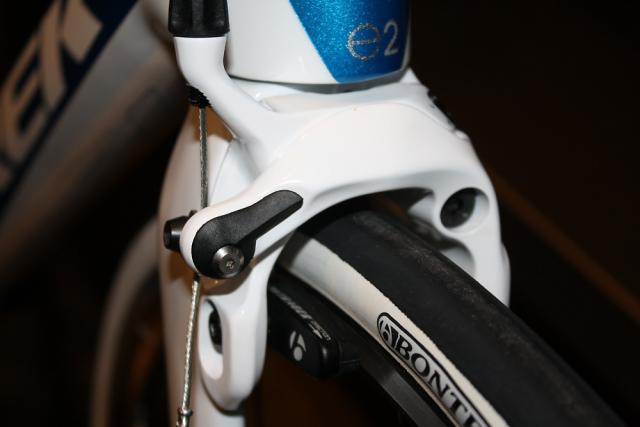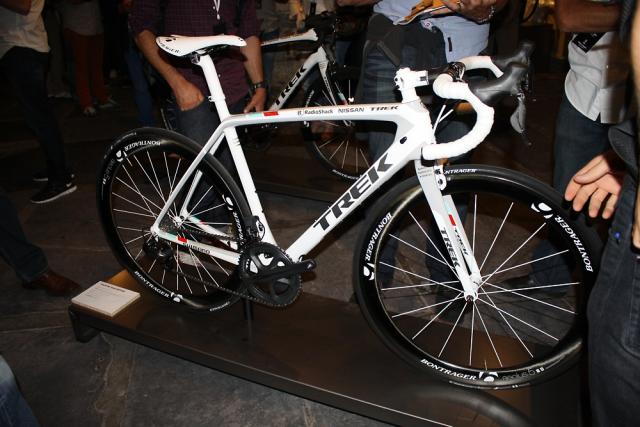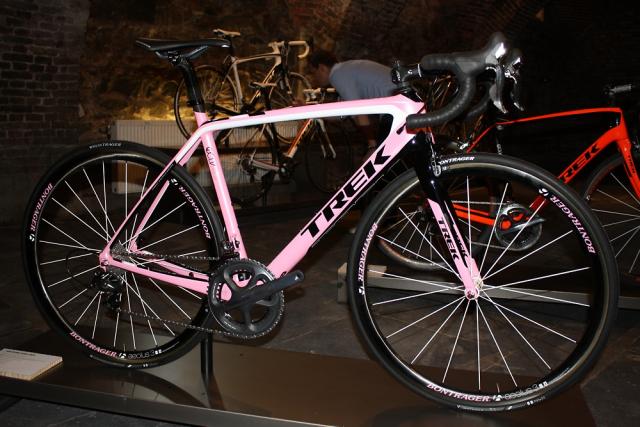- News
- Reviews
- Bikes
- Components
- Bar tape & grips
- Bottom brackets
- Brake & gear cables
- Brake & STI levers
- Brake pads & spares
- Brakes
- Cassettes & freewheels
- Chains
- Chainsets & chainrings
- Derailleurs - front
- Derailleurs - rear
- Forks
- Gear levers & shifters
- Groupsets
- Handlebars & extensions
- Headsets
- Hubs
- Inner tubes
- Pedals
- Quick releases & skewers
- Saddles
- Seatposts
- Stems
- Wheels
- Tyres
- Tubeless valves
- Accessories
- Accessories - misc
- Computer mounts
- Bags
- Bar ends
- Bike bags & cases
- Bottle cages
- Bottles
- Cameras
- Car racks
- Child seats
- Computers
- Glasses
- GPS units
- Helmets
- Lights - front
- Lights - rear
- Lights - sets
- Locks
- Mirrors
- Mudguards
- Racks
- Pumps & CO2 inflators
- Puncture kits
- Reflectives
- Smart watches
- Stands and racks
- Trailers
- Clothing
- Health, fitness and nutrition
- Tools and workshop
- Miscellaneous
- Buyers Guides
- Features
- Forum
- Recommends
- Podcast
TECH NEWS
Trek launch super-light, super-aero new Seven Series Madone (+ video)
Trek are launching a new version of their Madone road bike that is designed to be both ultra light and ultra aerodynamic; the US brand claims that the 2013 model puts in a market-leading all-round performance.
We’re in Belgium for the launch at the moment and we’ll be riding the new bike tomorrow. In the meantime, here are the highlights…
Aerodynamics
Trek have completely redesigned the Madone frame to incorporate aerodynamic tube profiles borrowed from their Speed Concept time trial bikes.
The fork blades, down tube, seat tube, and seatstays are all shaped to Trek’s Kammtail Virtual Foil (KVF) design. Check out our Speed Concept review for the full story on the design. In short, it’s an airfoil shape with the rear of the tail chopped off, yet the air travels in much the same way as if the tail was still there.

The advantages of the design are that it allows Trek to stick within the UCI’s equipment rules that limit the width to depth ratio of tubes, it saves weight, it and isn’t massively affected by crosswinds.

Trek have also brought in a completely new brake design in the name of aerodynamics. The front brake still sits at the front of the fork in the usual way but it’s much more integrated than a traditional design. One arm is attached at the fork crown and pivots centrally but the other one mounts directly to the fork leg.
The rear brake has been redesigned too, and it now sits beneath and behind the bottom bracket – as you’ll find on many TT bikes – where it’s more sheltered from the wind.

Moving the brake calliper away from the seatstays has allowed Trek to dispense with the brake bridge altogether. Check it out. It certainly looks strange to start with. Trek have been able to remove reinforcing layers of carbon from the seatstays too because there are no longer any braking forces in that area.
Trek claim that compared to the previous generation Madone, the new version has 330g less drag. That means you can go the same speed as before for 25W less effort (that’s at 40kph/25mph with a wind at 10° yaw). Or, for the same effort, a ride that would previously have taken an hour now takes 57:56mins, according to Trek’s figures.

Weight
The new Madone is the lightest ever, the top level frame coming in at just 750g. That’s superlight by anyone’s standards. To put it in perspective, the previous generation Madone was 915g – so the new one is a whopping 18% lighter.

Trek would like you to bear in mind that most other mega-light frames aren’t built to be aerodynamic. If you want an aero frame, you’re usually looking at well over 1,000g.
U5 Vapor Coat
If you really want to save every gram, you can go for a Madone with Trek’s new U5 Vapor coat, which is a superlight finish. A typical paint job might add somewhere between 40g and 80g which ain’t a lot, granted, but if you’re after the ultimate, that’ll never do.
With the U5 Vapor Coat, there are no transfers and Trek use the absolute minimum of paint. You’re looking at a weight of 5g.
Other features
Lots of brands have been working hard lately to keep a dropped chain from damaging your carbon and Trek have been doing their bit too. They’ve come up with their 3S integrated chain keeper which mounts directly to the Madone’s frame via a threaded hole just north of the bottom bracket. It’s a pretty minimalist design but Trek reckon it does the job.

The cable routing is internal and Trek integrate an Duotrap sensor into the non-driveside chainstay that you can link up to a wireless computer.
And finally
Trek are massively excited about this bike. Company President John Burke said at the launch in Spa, Belgium, that, “This is the most amazing bike Trek have ever come out with.”
And Trek’s pro riders Frank Schleck, Jens Voigt and Chris Horner all said good things at the launch too.
“I felt in two pedal strokes that it was something different,” said Jens, who saw prototypes a year ago and at various stages in the development process.

Of course, you cynical bunch will say that they would say that, wouldn’t that? And you might be right. We’ll find out tomorrow how all the changes stack up when we get to ride the new bike. Trek reckon that it offers the best combination you can get of high compliance, low drag, high frame stiffness and low weight, so they’re promising a lot.
The top level Madone on the previous incarnation was a 6 Series; this time Trek are pushing things up a level with the 7 Series which is what the Team RadioShack riders will be using. The KVF tubing and all the key features will be available on the 6 Series and 5 Series too. The bikes will hit the market from the end of July.
Meanwhile, Trek has released a short video in which some of the design team involved in the bike talk about its aerodynamic features, and which also includes comments from RadioShack-Nissan riders including Chris Horner.
Mat has been in cycling media since 1996, on titles including BikeRadar, Total Bike, Total Mountain Bike, What Mountain Bike and Mountain Biking UK, and he has been editor of 220 Triathlon and Cycling Plus. Mat has been road.cc technical editor for over a decade, testing bikes, fettling the latest kit, and trying out the most up-to-the-minute clothing. He has won his category in Ironman UK 70.3 and finished on the podium in both marathons he has run. Mat is a Cambridge graduate who did a post-grad in magazine journalism, and he is a winner of the Cycling Media Award for Specialist Online Writer. Now over 50, he's riding road and gravel bikes most days for fun and fitness rather than training for competitions.
Latest Comments
- chrisonabike 2 sec ago
So what you're saying is the "baseline" would move from "lit up like a Christmas tree" to "like a chameleon at a rave" * ... and it would have...
- Oldfatgit 9 min 3 sec ago
Thank you for asking Aidan, much appreciated....
- eburtthebike 8 hours 3 min ago
A sad case, and one with no winners. The driver can thank her lucky stars that the cyclist wasn't more seriously injured and that the court was...
- ktache 9 hours 8 min ago
And I liked endura too. Got a nice long sleeve mostly merino long sleeve a little while back, in orange.
- matthewn5 9 hours 36 min ago
No, the Ebay lights have been around for several years, this Lezyne light just appeared.
- chrisonabike 9 hours 52 min ago
They shouldn't worry - the second part of the "tariff" refrain is "they can make it in US and they'll do very well".
- Mr Blackbird 10 hours 24 min ago
"At the going down of the sun, it will get in our eyes and cause us to crash into things."
- Rendel Harris 10 hours 32 min ago
Been living in the area thirty years now and Brixton Cycles (and local riders wearing their famed Rastafarian colours jersey) has been an iconic...
- chrisonabike 15 hours 28 min ago
Indeed - but again these are perhaps questions we should keep asking. Even if the immediate answer is "well we are where we are" or "how on earth...



































Add new comment
16 comments
Looks good, great innovation Impressive weight and the back looks so much cleaner. Wonder about the back brake picking up all the dirt, etc and whether wet weather braking will be affected....
Impressive weight and the back looks so much cleaner. Wonder about the back brake picking up all the dirt, etc and whether wet weather braking will be affected....
The video gets a bit stupid about 2 minutes in.
That's just rubbish.
Good looking bikes. Love the look of the back without a bridge.
My considered opinion is that the orange and white is hideous, but the black and pink is high relevant to my interests.
I was just thinking that the black/pink is ok, but the orange looks awesome! oh well...
oh well...
Now I'm not usually quick to embrace change and this frame looks a bit weird without the bridge for a back brake but i think I like it
ludicrous and ridiculous, typical trek ....
my point entirely, Karbon Kev
Hi Kev. Just curious, what do you mean?
Hey Mr Trek-Guy
Fancy giving me one of these to promote on my blog? I REALLY REALLY would kill for one of these but could NEVER EVER afford to buy one
Gaz
(Dont get if you dont ask eh)
looks like they thought of the 'on the fly' rear brake adjustment by providing an in-line cable adjuster. Clever chaps!
Isn't the brake under the bottom bracket going to make it hell to change the rear wheel in a hurry? And you can't adjust it while riding. And it is positioned to get maximum muck from the road from the front wheel. Bet it won't work after a British winter. I used to have a U-brake on a hybrid bike in that position.
25w at 25mph.... Good job there's not a 12 stone rider on top with, like, you know, a whacking big torso, head and arms acting like a wind brake.
Which is why the 25watts is significant - it's such a large proportion of the overall drag on the frame, because the majority of the air resistance comes from the rider.
What I don't understand is why people disparage gains in some areas simply because the numbers in other areas are bigger. Sure, my position on the bike has far more effect on aerodynamics than the frame itself. But my position has to take other things in to consideration - sustainable comfort, avoiding injury, maintaining power output. So, if I've found the best riding position for me, bearing in mind the necessary compromises, why is a saving on the frame irrelevant just because the overall drag it causes is smaller than my body?
25w at 25mph is a pretty huge saving for a frame (even if the previous Madone was really unaerodynamic, that's still a big chunk). At that weight, it's very impressive. Be interested to hear how it rides.
Maybe I'm just being cynical, but has anybody else noticed how close to an old-fashioned tube these new 'aero' tubesets are? They must be much better though...